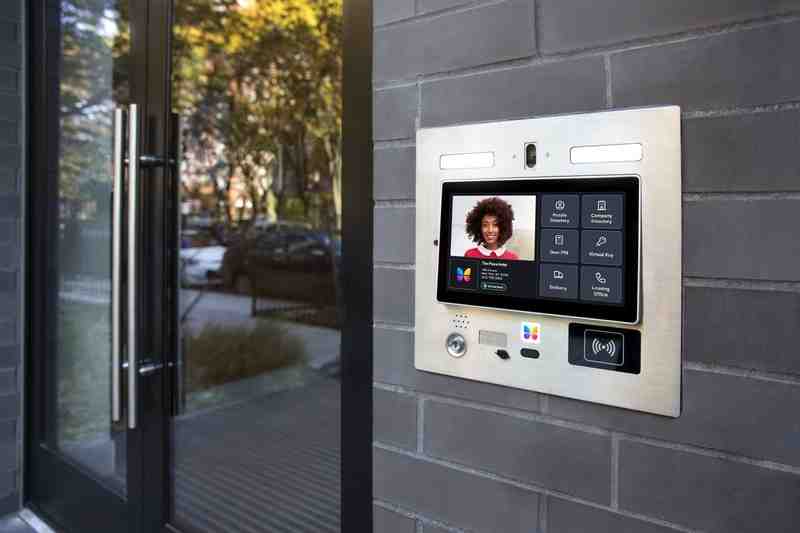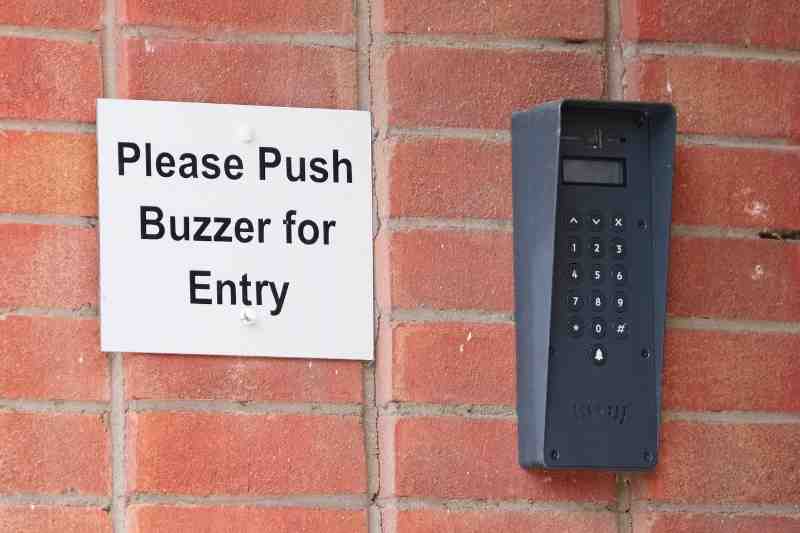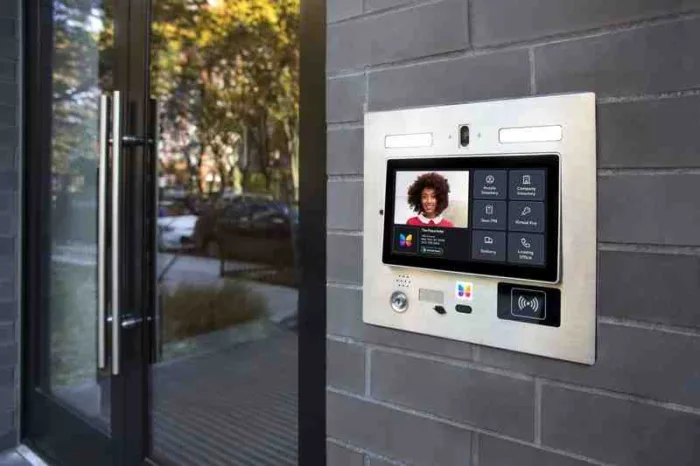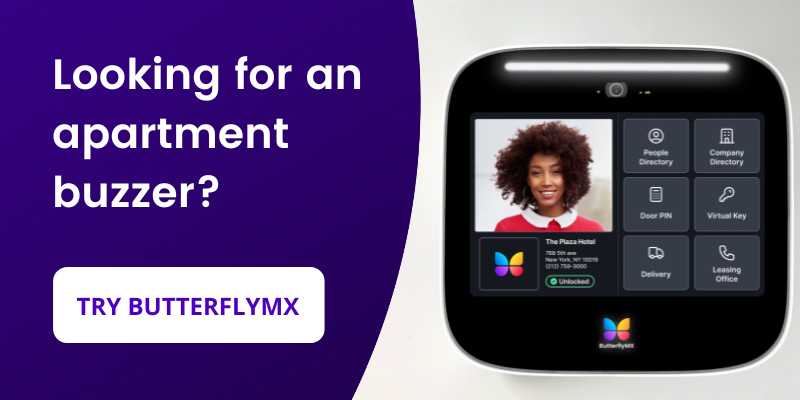Key takeaways:
- Wireless door buzzers are an upgrade from traditional wired systems.
- However, they lack modern features like cloud-based management and mobile access.
- Door buzzers still rely on in-unit hardware, making them less adaptable to today’s needs.

Are you upgrading or replacing the commercial door buzzer system at your building? There are a lot of options out there to choose from, and the correct choice means an easier access experience for residents, visitors, and staff. You might have come across the wireless door buzzer in your own research. But is it the right choice for your property?
In this post, we explain what a wireless door buzzer is and how it works. Then, we go over a few of the limitations of a wireless door buzzer system and offer better alternatives.
This post covers:
- What is a wireless door buzzer?
- How does a wireless door buzzer work?
- Wireless door buzzer limitations
- The best wireless door buzzer alternative
What is a wireless door buzzer?
A wireless door buzzer is a door entry system that uses a buzzing sound to alert a resident of a guest at their front door. Residents can then use the door buzzer system to let a guest in without having to go down to the door themselves. Wireless door buzzer systems allow a guest and a resident to communicate using wireless technologies.
All kinds of properties use wireless buzzers, from apartments to office complexes. However, buzzer system configurations might differ depending on the type of property you’re managing. In a multifamily building, each apartment unit usually has its own hardware that lets each tenant communicate with visitors individually. On the other hand, a commercial office building might instead direct all door entry requests to one central point, like a front desk or a receptionist.
Wireless door buzzer systems have 3 components:
- Base station. Base stations are installed at entryways. Guests use the base station to select the resident they’re visiting and initiate conversations. Base stations usually include a tenant directory, a call button, and a microphone. In some cases, the base station for a wireless buzzer with video will include a camera to facilitate video calls.
- Substations. Substations are the term for any hardware that a resident or tenant uses to interact with a door buzzer base station. From a substation, a resident can talk to a guest and press a button that unlocks the door. The substation makes a buzzing noise to let a resident know they have a guest.
- Electric lock. For a resident to unlock a door remotely, that door must have a lock that can be engaged or disengaged with an electric current. To unlock the door, tenants use the substation to send a signal to the electric lock, which then releases.
Watch how ButterflyMX works:
How does a wireless door buzzer work?
A wireless door buzzer works by enabling communication between a guest using a base station at a building’s entrance to a resident using a substation installed inside of the building. These communications occur wirelessly through the internet, a cell network, or radio waves.
As for the door buzzer itself, buzzers have many ways of producing sound. In older door buzzer systems, that signature “buzzing” sound was created when an electric current was sent to a buzzer component called a resonator. Now, however, remote door buzzers might depend on small, programmable speakers to create that buzzing sound. Newer buzzers have the advantage of being able to play any tone or sound a resident might want.
Listen to the sound a wireless door opener buzzer makes:
Here’s what happens when a guest using a wireless door buzzer requests access from a tenant:
- Guest selects resident. A guest selects the resident they’re visiting by using the directory on the base station.
- Substation buzzes. In the tenant’s apartment, the substation buzzes to let a resident know that they have a visitor.
- Resident and guest speak. Using the microphones installed in the substation and base station, the resident talks to the guest and verifies their identity.
- Resident grants entry. If the resident decides to grant entry, they press a button on their substation to initiate the door release process.
- Door unlocks. By pressing the button, the system sends an electrical signal that will disengage the electric lock.
- Base station buzzes. In addition to unlocking the door, this button also activates the buzzer at the entryway, signaling to a guest that the door is unlocked. The guest can now enter the property.
4 limitations of wireless door buzzers
Although a wireless door entry buzzer provides a way for renters to let visitors in remotely, it isn’t the best way to manage access for your property.
Wireless door buzzer entry systems have these four limitations:
- Residents must be in their apartments to use the door buzzer
- Not cloud-based
- Only controls access for guests, not residents
- In-unit hardware required
1. Residents must be in their apartments to use the door buzzer
In today’s increasingly connected world, renters expect more out of their access control systems. Internet-powered access control systems, which allow a resident to open doors from anywhere, are becoming standard.
For a tenant who’s not home — whether they’re across the country on vacation or across town at the grocery store — being able to open their door remotely for somebody like a house cleaner, dog walker, or friend is an incredible convenience. Unfortunately, door buzzers depend on in-unit hardware and don’t offer this option.
As a result, visitors who can’t reach their intended resident often call everyone in the building — which is also known as buzzer bombing. Apartment building buzzer bombing is both annoying to residents and a security risk to the property.
2. Not cloud-based
Buzzer entry systems aren’t cloud-based, which means staff can’t manage them remotely. Instead, property staff must go onsite to manually update the tenant directory or adjust access permissions.
A cloud-based entry system saves time and effort for building staff. Since staff can manage the system on the go, they have more time to focus on other tasks that will improve the resident experience.

3. Only controls access for guests, not residents
A wireless door lock buzzer might provide an adequate way for a tenant to let a guest in. However, door buzzers are built only to manage access for guests and can serve no other purpose. Residents can’t use the buzzer to open the door for themselves.
If you install a wireless buzzer system, you’ll have to install an additional access control system — like a key or fob reader — to actually give your residents a way into the building.
4. In-unit hardware required
It’s true that installing a wireless door buzzer is simpler than installing a wired door buzzer. Wireless systems have many benefits, including the fact that you no longer have to rip up walls and floors to install or maintain wiring.
However, a wireless buzzer system still requires you to install hardware in every unit in addition to installing a base station at the entrance. The cost of purchasing, installing, and maintaining all that hardware adds up.
The best wireless door buzzer alternative
Even the most advanced door buzzers have limited functionality and don’t offer as much convenience as other building access systems. The best wireless door buzzer alternative is a mobile access control system, like ButterflyMX, that residents can control with their smartphones.
These days, everybody has a smartphone in their pocket. And with our mobile app, your residents will be able to use their smartphones as substations. This benefits both managers and residents. A manager will no longer have to spend time, money, and energy installing and maintaining dozens of individual substations. And residents can use their smartphones to open the door from anywhere.
Our cloud-based ButterflyMX OS also improves administration capabilities for building staff, who will appreciate features like an audit trail of all door releases and integrations with other property management services. Plus, take advantage of our fully integrated keypads and elevator controls, allowing you to use one access control system to extend a unified experience throughout your entire building.






